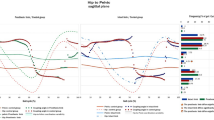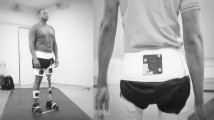Abstract
When applying prosthetic gait training to patients with lower limb amputation, monitoring the gait change process is crucial for establishing and modifying rehabilitation training plans. In addition, since human gait involves complex movement of several joints, it is necessary to analyze the organic movement of adjacent joints rather than a single joint in the lower extremities for understanding the process of gait change. Therefore, this study aimed to analyze changes in spatiotemporal parameters and lower limb coordination during prosthetic gait training in unilateral transfemoral amputees (TFAs). This retrospective case–control study included 10 unilateral TFAs and 10 healthy individuals as controls. TFAs received prosthetic gait training for 12 weeks and gait changes were analyzed every 2 weeks using a 3D motion analysis system. The measured variables were spatiotemporal parameters and the continuous relative phase between hip and knee joints. The highest improvement in walking speed was seen at week 4 of training, and the continuous relative phase was most symmetric at week 8. The lower limb coordination pattern was more in-phase in the TFAs than in the controls, and the coordination variability was also lower for the TFAs than for the controls. In addition, the rate of change in lower limb coordination of TFAs was lower than that of spatiotemporal parameters and was significantly different from that of the controls even after training. Considering that the decrease in lower limb coordination is related to gait efficiency, balance, and risk of fall, there is a need to develop therapeutic strategies that can further improve the coordination of TFAs.



Similar content being viewed by others
Abbreviations
- CRP-RMS:
-
Continuous relative phase–root mean square
- CRP-SD:
-
Continuous relative phase–standard deviation
- SI:
-
Symmetry index
- SLR:
-
Step length ratio
- SLSR:
-
Single-limb support ratio
- STR:
-
Stance time ratio
- STPs:
-
Spatiotemporal parameters
- TFAs:
-
Transfemoral amputees
References
Jaegers, S. M., Arendzen, J. H., & de Jongh, H. J. (1995). Prosthetic gait of unilateral transfemoral amputees: A kinematic study. Archives of Physical Medicine and Rehabilitation, 76(8), 736–743. https://doi.org/10.1016/s0003-9993(95)80528-1
Bae, A. (2017). Effectiveness of proprioceptive neuromuscular facilitation in comparison to traditional prosthetic training on unilateral lower limb amputee gait: a meta-analysis. PhD Thesis.
Boonstra, A., et al. (1994). The gait of unilateral transfemoral amputees. Scandinavian Journal of Rehabilitation Medicine, 26(4), 217–223.
Michaud, S. B., Gard, S. A., & Childress, D. S. (2000). A preliminary investigation of pelvic obliquity patterns during gait in persons with transtibial and transfemoral amputation. Journal of Rehabilitation Research and Development, 37(1), 1–10.
Villa, C., et al. (2015). Evolution of vaulting strategy during locomotion of individuals with transfemoral amputation on slopes and cross-slopes compared to level walking. Clinical Biomechanics, 30(6), 623–628. https://doi.org/10.1016/j.clinbiomech.2015.03.022
Gaunaurd, I., et al. (2011). Postural asymmetries in transfemoral amputees. Prosthetics and Orthotics International, 35(2), 171–180. https://doi.org/10.1177/0309364611407676
Nelson, L. (2013). Gait deviations after limb loss. Fundamentals of Amputation Care and Prosthetics, 202.
Kulkarni, J., et al. (2005). Chronic low back pain in traumatic lower limb amputees. Clinical Rehabilitation, 19(1), 81–86. https://doi.org/10.1191/0269215505cr819oa
Morgenroth, D. C., et al. (2010). the relationship between lumbar spine kinematics during gait and low-back pain in transfemoral amputees. American Journal of Physical Medicine and Rehabilitation, 89(8), 635–643. https://doi.org/10.1097/phm.0b013e3181e71d90
Chang, Y. H., et al. (2011). Intact hip and knee joint moment in coronal plane with unilateral transfemoral amputee. International Journal of Precision Engineering and Manufacturing, 12(1), 129–134. https://doi.org/10.1007/s12541-011-0016-9
Chang, Y. H., et al. (2012). Relationship between ankle inversion angle and knee adduction moment on the intact limb in unilateral transfemoral amputees during walking. International Journal of Precision Engineering and Manufacturing, 13(4), 609–615. https://doi.org/10.1007/s12541-012-0078-3
Norvell, D. C., et al. (2005). The prevalence of knee pain and symptomatic knee osteoarthritis among veteran traumatic amputees and nonamputees. Archives of Physical Medicine and Rehabilitation, 86(3), 487–493. https://doi.org/10.1016/j.apmr.2005.04.004
Struyf, P. A., et al. (2009). The prevalence of osteoarthritis of the intact hip and knee among traumatic leg amputees. Archives of Physical Medicine and Rehabilitation, 90(3), 440–446. https://doi.org/10.1016/j.apmr.2008.08.220
Esquenazi, A., & DiGiacomo, R. (2001). Rehabilitation after amputation. Journal of the American Podiatric Medical Association, 91(1), 13–22. https://doi.org/10.7547/87507315-91-1-13
Esquenazi, A. (2014). Gait analysis in lower-limb amputation and prosthetic rehabilitation. Physical Medicine and Rehabilitation Clinics, 25(1), 153–167. https://doi.org/10.1016/j.pmr.2013.09.006
Highsmith, M. J., et al. (2016). Gait training interventions for lower extremity amputees: A systematic literature review. Technology and Innovation, 18(2–3), 99–113. https://doi.org/10.21300/18.2-3.2016.99
Baker, P., & Hewison, S. (1990). Gait recovery pattern of unilateral lower limb amputees during rehabilitation. Prosthetics and Orthotics International, 14(2), 80–84. https://doi.org/10.3109/03093649009080327
Skinner, H. B., & Effeney, D. J. (1985). Gait analysis in amputees. American Journal of Physical Medicine and Rehabilitation, 64(2), 82–89. PMID: 3887934.
Winter, D. A. (2009). Biomechanics and motor control of human movement. John Wiley & Sons.
Haddad, J. M., et al. (2006). Adaptations in interlimb and intralimb coordination to asymmetrical loading in human walking. Gait and Posture, 23(4), 429–434. https://doi.org/10.1016/j.gaitpost.2005.05.006
Chiu, S.-L., Lu, T.-W., & Chou, L.-S. (2010). Altered inter-joint coordination during walking in patients with total hip arthroplasty. Gait and Posture, 32(4), 656–660. https://doi.org/10.1016/j.gaitpost.2010.09.015
Xu, Z., et al. (2020). Lower limb inter-joint coordination of unilateral transfemoral amputees: Implications for adaptation control. Applied Sciences, 10(12), 4072. https://doi.org/10.3390/app10124072
Wang, T.-M., et al. (2009). Bilateral knee osteoarthritis does not affect inter-joint coordination in older adults with gait deviations during obstacle-crossing. Journal of Biomechanics, 42(14), 2349–2356. https://doi.org/10.1016/j.jbiomech.2009.06.029
Krasovsky, T., et al. (2014). Effects of walking speed on gait stability and interlimb coordination in younger and older adults. Gait and Posture, 39(1), 378–385. https://doi.org/10.1016/j.gaitpost.2013.08.011
Broomhead, P., et al. (2003). Evidence based clinical guidelines for the physiotherapy management of adults with lower limb prostheses. British Association of Chartered Physiotherapists in Amputation Rehabilitation.
Kadaba, M. P., Ramakrishnan, H., & Wootten, M. (1990). Measurement of lower extremity kinematics during level walking. Journal of Orthopaedic Research, 8(3), 383–392. https://doi.org/10.1002/jor.1100080310
Sadeghi, H., Allard, P., & Duhaime, M. (2001). Muscle power compensatory mechanisms in below-knee amputee gait. American Journal of Physical Medicine and Rehabilitation, 80(1), 25–32. https://doi.org/10.1097/00002060-200101000-00007
Bohannon, R. W. (1997). Comfortable and maximum walking speed of adults aged 20–79 years: Reference values and determinants. Age and Ageing, 26(1), 15–19. https://doi.org/10.1093/ageing/26.1.15
Perry, J. (1992). Gait analysis: Normal and pathological function. SLACK, 12, 815.
Burgess-Limerick, R., Abernethy, B., & Neal, R. J. (1993). Relative phase quantifies interjoint coordination. Journal of Biomechanics, 26(1), 91–94. https://doi.org/10.1016/0021-9290(93)90617-n
Hamill, J., et al. (1999). A dynamical systems approach to lower extremity running injuries. Clinical biomechanics, 14(5), 297–308. https://doi.org/10.1016/s0268-0033(98)90092-4
Chiu, S. L., Osternig, L., & Chou, L. S. (2013). Concussion induces gait inter-joint coordination variability under conditions of divided attention and obstacle crossing. Gait and Posture, 38(4), 717–722. https://doi.org/10.1016/j.gaitpost.2013.03.010
Kurz, M. J., Stergiou, N., Buzzi, U. H., & Georgoulis, A. D. (2005). The effect of anterior cruciate ligament recontruction on lower extremity relative phase dynamics during walking and running. Knee Surgery, Sports Traumatology, Arthroscopy, 13(2), 107–115. https://doi.org/10.1007/s00167-004-0554-0
Yiğiter, K., et al. (2002). A comparison of traditional prosthetic training versus proprioceptive neuromuscular facilitation resistive gait training with trans-femoral amputees. Prosthetics and orthotics international, 26(3), 213–217. https://doi.org/10.1080/03093640208726650
Orendurff, M. S., et al. (2004). The effect of walking speed on center of mass displacement. Journal of Rehabilitation Research and Development, 41(6), 829. https://doi.org/10.1682/JRRD.2003.10.0150
Nadollek, H., Brauer, S., & Isles, R. (2002). Outcomes after trans-tibial amputation: The relationship between quiet stance ability, strength of hip abductor muscles and gait. Physiotherapy Research International, 7(4), 203–214. https://doi.org/10.1002/pri.260
Esposito, E. R., & Wilken, J. M. (2014). The relationship between pelvis–trunk coordination and low back pain in individuals with transfemoral amputations. Gait and Posture, 40(4), 640–646. https://doi.org/10.1016/j.gaitpost.2014.07.019
Highsmith, M. J., et al. (2010). Differences in the spatiotemporal parameters of transtibial and transfemoral amputee gait. JPO Journal of Prosthetics and Orthotics, 22(1), 26–30. https://doi.org/10.1097/jpo.0b013e3181cc0e34
Hamill, J., Palmer, C., & Van Emmerik, R. E. (2012). Coordinative variability and overuse injury. BMC Sports Science, Medicine and Rehabilitation. https://doi.org/10.1186/1758-2555-4-45
Chiu, S.-L., & Chou, L.-S. (2012). Effect of walking speed on inter-joint coordination differs between young and elderly adults. Journal of biomechanics, 45(2), 275–280. https://doi.org/10.1016/j.jbiomech.2011.10.028
Murray, M. P., et al. (1980). Gait patterns of above-knee amputees using constant-friction knee components. Bulletin of prosthetics research, 10, 35–45. PMID: 7260459.
Gabell, A., & Nayak, U. S. L. (1984). The effect of age on variability in gait. Journal of Gerontology, 39(6), 662–666. https://doi.org/10.1093/geronj/39.6.662
Miller, R. H., Lowry, J. L., Meardon, S. A., & Gillette, J. C. (2007). Lower extremity mechanics of iliotibial band syndrome during an exhaustive run. Gait and posture, 26(3), 407–413. https://doi.org/10.1016/j.gaitpost.2006.10.007
Ma, C.Z.-H., et al. (2015). A vibrotactile and plantar force measurement-based biofeedback system: Paving the way towards wearable balance-improving devices. Sensors, 15(12), 31709–31722. https://doi.org/10.3390/s151229883
Funding
This research was supported by the Bio and Medical Technology Development Program of the National Research Foundation (NRF) funded by the Ministry of Science & ICT (No.2017M3A9E2063255)
Author information
Authors and Affiliations
Corresponding author
Additional information
Publisher's Note
Springer Nature remains neutral with regard to jurisdictional claims in published maps and institutional affiliations.
Appendix
Appendix
Gait laboratory schematics

Rights and permissions
About this article
Cite this article
Chang, Y., Ko, CY., Jeong, B. et al. Changes in Spatiotemporal Parameters and Lower Limb Coordination During Prosthetic Gait Training in Unilateral Transfemoral Amputees. Int. J. Precis. Eng. Manuf. 23, 361–373 (2022). https://doi.org/10.1007/s12541-021-00605-y
Received:
Revised:
Accepted:
Published:
Issue Date:
DOI: https://doi.org/10.1007/s12541-021-00605-y




